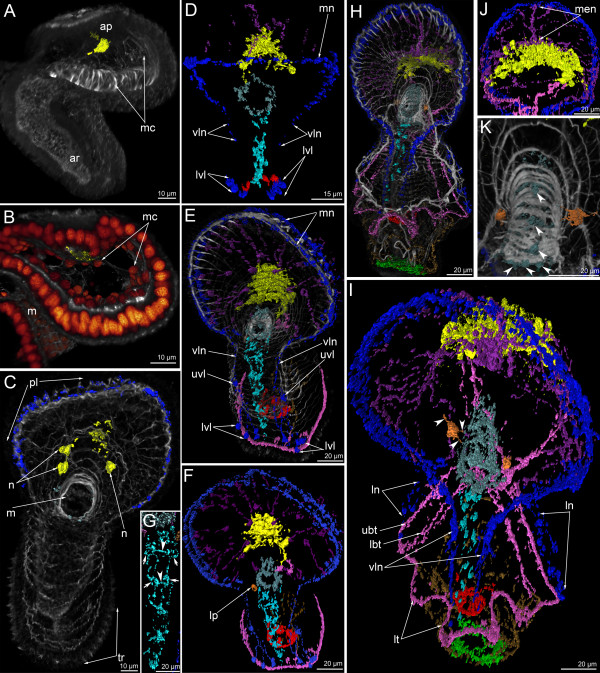Figure 10.
Three-dimensional reconstructions of the FMRFamide-like immunoreactive nervous system in consecutive stages of development. Color: yellow – apical organ; pink – tentacular neurites; light green – telotroch neurites; cyan – ventral neurite bundle; pale blue – oral nerve ring; dark blue – marginal neurites of the preoral lobe edge, lateral (lt) and ventro-lateral (vln) neurites of the oral field, upper ventro-lateral perikarya, and lower ventro-lateral perikarya; brown – trunk neurites; magenta – neurites and perikarya of the preoral lobe; orange – large perikarya near the mouth (lp); red – circular neurites circle with perikarya around the midgut; reddish-orange – nuclei; grey/white – muscle system and all actin-containing structures (parietal cytoplasm, microvilli, etc.). Apical is to the top in all cases. (A) General view of a late gastrula showing apical plate (ap), archenteron (ar), and mesodermal cells (mc). Lateral view; ventral is to the right. (B) Anterior portion of the body of a late gastrula. Close contact between the neuropil of the apical organ (yellow) and mesodermal cells (mc) is evident. Sagittal optical section through the mouth (m); ventral is to the right. (C) Young actinotrocha; overview of the musculature and the FMRFamide-like immunoreactive nervous system showing the first perikarya (n) of the apical organ, the preoral lobe (pl) with marginal neurite bundle, the mouth with the oral nerve ring (or), and the tentacular ridge (tr). Ventral view. (D) Organization of the nervous system in the young actinotrocha. At this stage, the ventro-lateral neurites (vln) of the oral field, the marginal neurite bundle (mn) of the preoral lobe, the lower ventro-lateral perikarya (lvl), and the midgut perikarya are present. (E) Overview of the musculature and the nervous system in a 6-day-old larva; ventro-lateral view. The stack, which was used to produce the micrographs, lacks the most dorsal optical sections and the tentacular neurite bundle is not visible in the most dorsal region. The marginal neurite bundle (mn) of the preoral lobe continues towards the oral field and passes into the ventro-lateral neurites (lvn), which connect with the upper ventro-lateral perikarya (uvl), and the lower ventro-lateral perikarya (lvl). (F) Nervous system of a 6-day-old larva. (G) Ventral line of the oral field with ventral neurite bundles with associated paired perikarya (arrows) and commissures (arrowheads). (H) Overview of the musculature and nervous system in a 24-day-old larva; ventro-lateral view. (I) Organization of the FMRFamide-like immunoreactive nervous system in a 24-day-old larva; ventro-lateral view showing lateral neurites (ln), ventro-lateral neurites (vln), the upper branch of the tentacular neurite bundle (ubt), the lower branch of the tentacular neurite bundle (lbt), and the loops of the tentacle neurites (lt). Neurites of a large perikaryon near the mouth are indicated by arrowheads. (J) Dorsal view of the preoral lobe with large apical organ and radial neurites including the prominent median neurite bundle (men). (K) Dorsal view of the esophageal musculature and the nervous system (perikarya are indicated by arrowheads).

